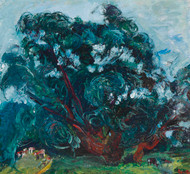Chaim Soutine (1893-1943)
Published by Therese Myles on 16th Sep 2019
Chaim Soutine was born Jewish in Germany in 1843 as the tenth of 11 children in an extremely poor family and was beaten for drawing- which was forbidden, as he was Jewish. Soutine offered to draw an old neighbor's portrait for 25 rubles, and was beaten by the sons of the man, very cruelly. He used the money given to him by the man to attend art school in Vilna in 1910 before he managed to save the money for a fourth-class train ticket to Paris circa 1913, despite his family's strong disposition to his interest in art.
Soutine gained his influence for his impressions through his various visits between to the Louvre and the various works of Cezanne, van Gogh, and Bonnard, eventually finding his way to Expressionism, and through his studies, he was introduced to several art patrons and dealers, where Soutine learned how to market his artwork- however poorly he actually ended getting paid for it. He was miserably poor and most of his close friends couldn't understand his motivation to work through his misery. Luckily (ironically enough for Chaim), he was financially used to dealing with poverty because of his childhood, but the inability to find success took it's toll on his physical and mental health- and it was reflected in his artwork. He worked several jobs during this time to make ends meet, including porting at the railway station, and digging ditches during the war.
Soutine was said to have developed his passion for color dynamism through susceptible, restless shapes, and after his first years in Paris, Soutine had found himself working in the Ceret in the French Pyreneese for over three years, until 1919, painting over 200 different pictures in the time frame (mostly landscapes, and a very few certain portraits that showed some trademarked style in 1916. Chaim had many different visionary style paintings, some of apocalyptic landscapes with dynamic, deep brush strokes. His financial situation improved over time and after an American collector Alfred Barnes bought many of his pictures in 1925 and he moved to Cagnes- where his palette becomes brighter and more lively, likely because of his change of climate. His later works distortions and emotionality ease off from the apocalyptic works of his past, and most of his paintings from 1925-1929 are mostly still lives of game, poultry, beef carcasses, fish, uniformed hotel and restaurant waiters, and oddly enough, choirboys. At this point, Chaim Soutine appeared to be striving to have a modern, Courbet or Rembrandt type of style, didn't have to worry about financial deprivation, and found himself avoiding Paris because of his broken relationships with his previous friends- this is when he developed a sense of self-hatred, and unconvinced of its quality, Soutine was known to have destroyed all of the pieces he managed to get a hold of because he believed them to be inferior and sub-par.
Sadly, as the Nazi occupation of France occurred in 1943 forced him out of Paris because he was registered as a Jew. While his friends helped him to survive, an old stomach ulcer became aggravated because of his stress, and it took him far too long to get to a doctor because of the Occupation risks. Only after his death in 1943, did the vivid colors and passionate display of paint gain him recognition as one of the foremost Expressionist painters.

